Research
My research encompasses the broad areas of multiscale mechanics, sustainable materials, and resilient infrastructure. It primarily centers around asphalt binder chemo-mechanics, followed by asphalt mixture performance testing and multiscale modeling across the binder and mixture scales. While the material research serves as the primary tool to understand and model the underlying mechanics, my research inquiry extends into the key areas of pavement recycling, incorporation of waste materials, and development of frameworks aimed at enhancing pavement recycling practices. My work encompasses macro scale behaviors where the pavement is treated as a single structural entity exposed to external factors such as traffic, climatic conditions, and the uncertainties thereof. This research involves assessing the impact of extreme events and climate change employing novel metrics and methodologies involving pavement design, analysis, and simulations. Recognizing the criticality of the pavement network as a vital facet of transportation infrastructure, my work also aims to address the system level issues facing pavement infrastructure. This research delves into the intricate interplay of pavement management and preservation activities, guided by insights derived from material mechanics, pavement performance, and external factors. Employing systems analysis such as system dynamics, agent-based modeling, and scenario analysis, this research comprehensively explores the complexities inherent in pavement networks. The schematic below encapsulates the trajectory of my research, illustrating how bottom-up studies inform the top-down analyses, and vice-versa. Please continue scrolling down for selected snapshots showcasing key aspects of my research endeavors thus far.
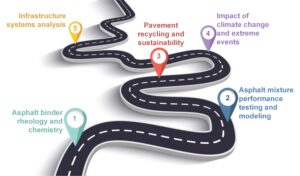
From material fundamentals to sustainable and resilient infrastructure
Modeling and study of infrastructure materials
-
Multiscale mechanics and modeling of asphalt materials
My multiscale research efforts are concentrated on the examination of cause-and-effect relationships within diverse material and system scales. To date, my primary emphasis has been on the asphalt binder and mixture scales, involving comprehensive investigations into material characterization and performance evaluation at these levels. The insights derived from material-level studies have been extrapolated to the network scale, facilitating an assessment of the ramifications of climate change on material selection, pavement performance, and the overall vulnerability of road infrastructure.
 Multiscale evaluation and modeling: from material mechanics to performance evaluation of pavement networks (Figure credits: Prof. Shane Underwood)
Multiscale evaluation and modeling: from material mechanics to performance evaluation of pavement networks (Figure credits: Prof. Shane Underwood)
-
Nonlinear viscoelastic analysis of asphalt binders
Extensive investigations have historically focused on the linear viscoelastic properties of asphalt binders, from which performance metrics have been derived and employed for specification purposes. However, in the context of their application in asphalt concrete pavements, these materials may encounter time-dependent loads within the nonlinear regime. Historically, a significant majority of asphalt binders displayed robust correlations between their linear and nonlinear characteristics. Consequently, despite the divergence in characterization and actual field usage domains, a system predicated on linear properties could be reliably implemented.
Recent advancements, however, have introduced novel binders and additives that exhibit distinct relationships between linear and nonlinear behaviors. Consequently, there arises a necessity to thoroughly characterize the asphalt binder response under conditions of large strains and to formulate specifications that explicitly accommodate the inherent binder nonlinearity. My research endeavors aim to address this imperative by undertaking the characterization of the nonlinear rheological properties of asphalt binders through the application of large amplitude oscillatory shear. The analysis of modified binders under substantial strains involves the utilization of Lissajous-Bowditch plots, while the assessment of higher harmonics contribution is conducted through Fourier-transform rheology. Furthermore, the elastic and viscous components are delineated using stress decomposition to an orthogonal set of Chebyshev polynomials.

3D-Xray tomography of a terminally blended crumb rubber modified asphalt binder

The stress response as a function of time and the corresponding Fourier spectra
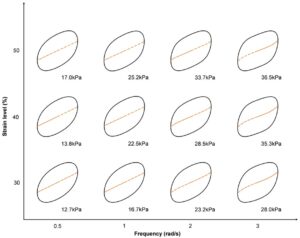
Normalized Lissajous-Bowditch curves at Tref = 30°C for total stress response (full closed loop) and elastic stress response (dotted line) as a function of strain
-
Continuum damage and healing mechanics
Asphalt binder is a viscoelastic material, meaning its response is time- and temperature-dependent. As a result, its material properties change as the in-service traffic and climatic conditions change. As part of the pavement, asphalt binder undergoes varying amounts of loading, ranging from small to very high, causing the viscoelastic response to go from linear to nonlinear. The binder also undergoes damage by developing microcracks over time that eventually appear as different distresses in the pavement and result in weakening of the overall pavement structure. Further, as the asphalt binder is exposed to the environmental conditions, it “ages” due to physical and chemical changes occurring over time. This aging is characterized by an increase in stiffness and brittleness of the binder and makes it more susceptible to damage. One of the astonishing properties of asphalt binder is its ability to self-heal and reverse some of this microdamage during the load rest periods. So, there is an active dynamic of viscoelastic response, damage, and healing compounded by aging in asphalt binders and its understanding is vital for improving the service life of pavements. My work focuses on characterizing and modeling these phenomena of damage and healing while accounting for nonlinear viscoelasticity and thixotropy in the binder response.

Phenomenology of nonlinearity, thixotropy, damage and healing (partially adapted from Leegwater et al. (2021) and Miglietta et al. (2023))
-
Performance evaluation of infrastructure materials
Experimental testing spanning multiple scales of infrastructure materials.
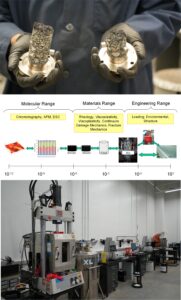
(Credits: Prof. Shane Underwood and Asphalt Multiscale Mechanics lab at NC State University)
Sustainable infrastructure materials
-
Increased use of recycled asphalt pavement (RAP)
The use of asphalt mixtures containing previously paved asphalt mixture from milled pavements, so-called reclaimed asphalt pavements or RAP, has been around for more than half a century. For many years, the typical content levels were low enough that the asphalt mixtures containing recycled asphalt materials could be reliably designed through the methods used to design mixtures that did not contain recycled materials without any substantial modifications. In the early 2000s, the National Cooperative Highway Research Program
(NCHRP) Project 09–12 recommended using the same virgin asphalt binder grade for the mixtures containing up to 20% RAP content depending on the RAP binder stiffness. However,
in recent years the recycled asphalt material contents have increased and now it is common to design mixtures with 30% or higher RAP. At these higher recycled contents, the effect of
the recycled material begins to affect the behaviors of these asphalt mixtures and alter the pavement performance, which may result in diminishing returns at or beyond a certain incorporation dosage level if proper measures are not taken. My research focuses on finding ways to increase the proportioning of RAP while ensuring acceptable pavement performance, sustainable reuse, and economic benefits both in the short- and long-term. In order to enable use of more recycled asphalt materials without compromising the pavement performance, many strategies have been employed such as using a softer PG grade virgin binder, warm-mix additives, RAs, or a combination thereof. Alternate mix design methods are also currently evaluated which account for RAP binder availability and binder activity of any additives. if used.

-
Research on the use of recycling agents (RAs)
There have been many efforts to study the positive reuse of asphalt mixture. Relatively recently, the use of RAs has become a widely available tool for engineers to further increase the use of recycled materials and still ensure good performing pavements. NCHRP Project 09–58 served as an experimentally rigorous effort to advance and consolidate the existing knowledge on the use of RAs. The research projects on the use of RAs by North Carolina DOT and Virginia DOT have made significant advancement in developing engineered frameworks for screening and selecting dosages of RAs. However. many question still need to be answered, which are the focus of my ongoing research. These include
- First and foremost, a robust classification system that is blind to the origin or source of RAs does not exist. The closest method to this goal that currently exists is the Texas A&M University’s classification system; however, it is purely based on rejuvenation mechanism (three in this case), which is an oversimplified version of complex interaction of virgin binder, RAP binder, and RA. A chemical-, rheological-, and microstructural classification system that focuses on dissecting the mechanisms at play would allow better selection
and screening of RAs. - The dosage selection methods focus on one property at a time while ensuring acceptable performance at other temperatures or conditions. A unified dosage selection method that ensures optimal performance across all conditions such as low-, intermediate-, and high temperature conditions as well as chemical compatibility does not exist yet.
- Modeling efforts to capture the effect of RAs on rheology and performance of both recycled binder blends and mixtures are very limited. Also, studies focusing on the blend of RAP and RAs only or virgin binder and RAs only to understand the underlying mechanisms at work and the impact of RAs on different performance indicators can be helpful in this regard. These studies should include tests in addition to the traditional testing such as FTIR, GPC, MFT, etc.
- The cost of using RAs will depend on the type and amount of RA that is being used. Therefore, cost consideration in the selection and screening of RAs can be of prime importance. Developing a methodology to consider the cost of RAs in their selection or evaluation for use in recycled pavements is much needed.
- Since most of the RAs are chemically active, it is essential to study the environmental impacts of recycling agents both in the short-term and long-term.
- With increasing use of RAs in the recycling asphalt pavements, the recyclability of the recycled asphalt materials containing RAs for future use, needs to be studied and accounted for in life-cycle assessment (LCA) and life-cycle cost analysis (LCCA). In other words, how sustainable and recyclable is the sustainable use of RAs in recycling asphalt pavements.

Infrastructure resilience
-
Impact of external factors on pavement performance
Road infrastructure is engineered to perform through constant exposure to climatological stressors. Due to climate change in particular, expected rises in the average ambient and extreme temperatures, pavement performance might deviate from what was originally predicted at the design stage. This poses serious risks to the long-term performance of this infrastructure because the capacity of a transportation network to provide an acceptable level of service over the period that it was intended for is also seriously affected. However,
identifying where potential risks are greatest and where more involved planning and prioritizing is needed is hampered by the lack of vulnerability assessment methods that appropriately integrate failure pathways and engineering decisions. My work in this direction have been on assessing the vulnerability of pavement infrastructure to temperature rise due to climate change. Additionally, the impact of extreme events such as flooding and heatwaves on pavement structural performance has also been modeled and evaluated for different future scenarios.
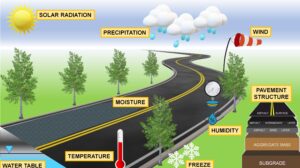
Climatic factors that affect flexible pavement performance
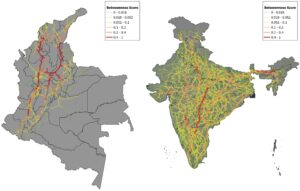
Betweenness score for the road networks of Colombia and India
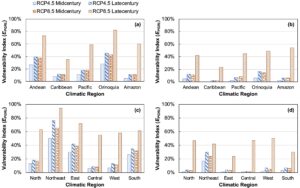
Vulnerability of pavement infrastructure to temperature rise due to climate change for Colombia (a) 50% reliability; and (b) 98% reliability, and for India (c) 50% reliability; and (d) 98%reliability
 Fatigue damage under different flooding and design scenarios
Fatigue damage under different flooding and design scenarios